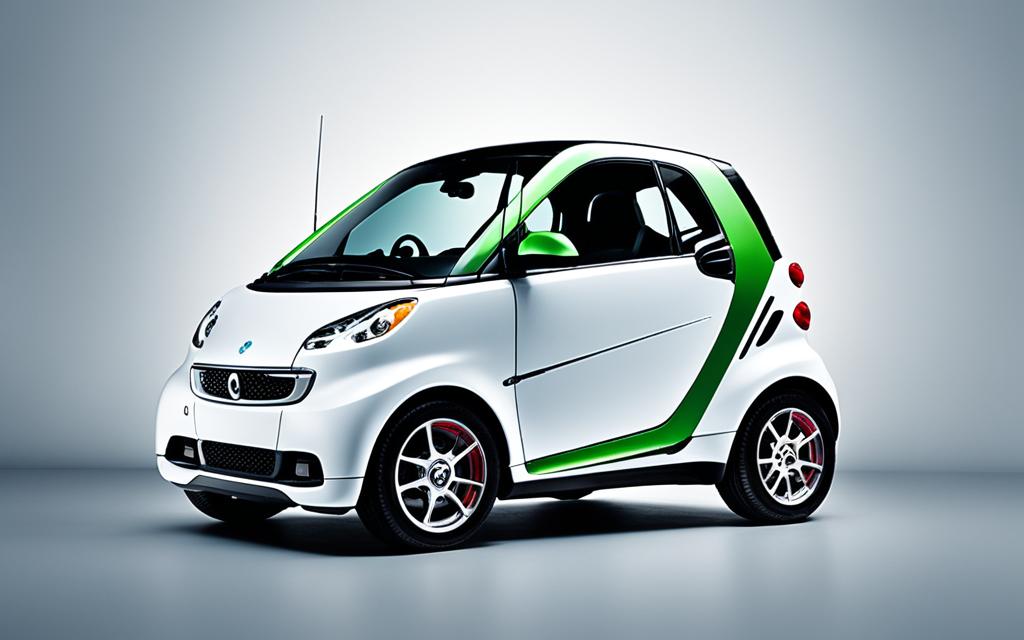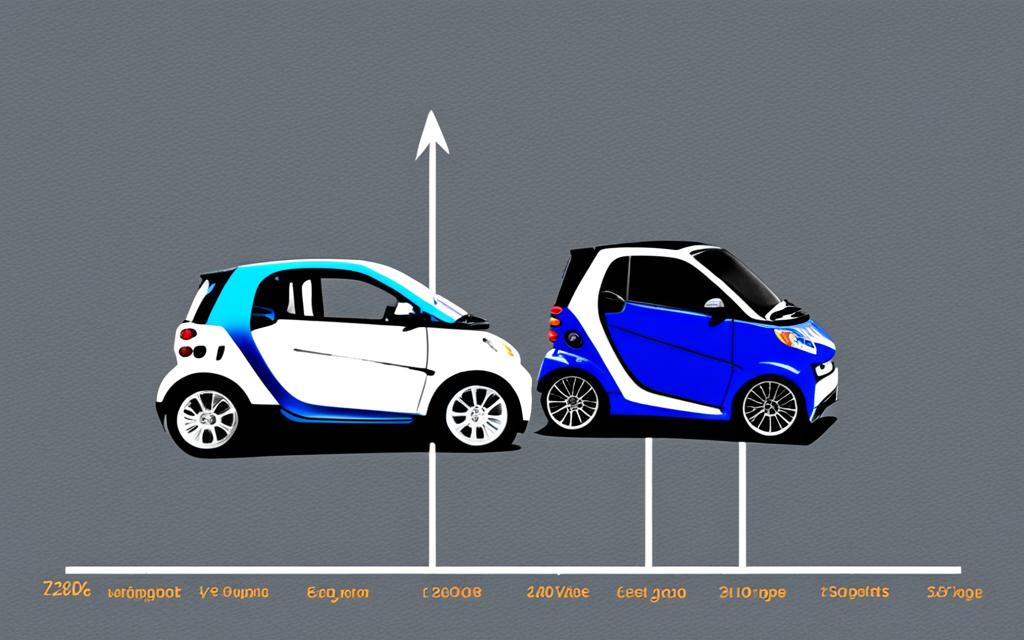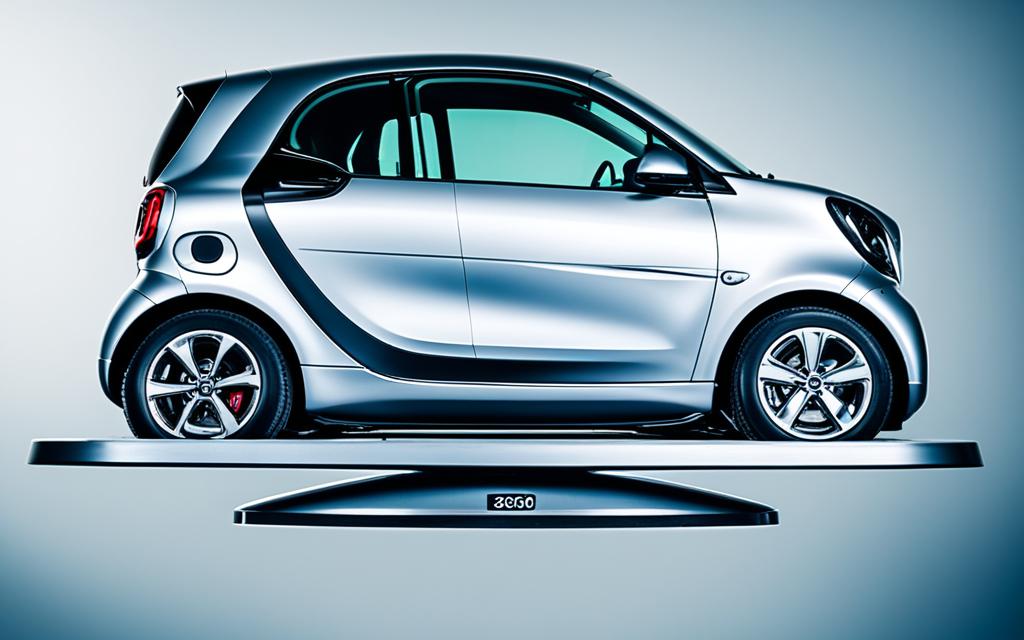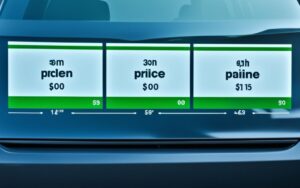Welcome to our informative guide on the weight of a smart car! If you’re wondering how much does a smart car weighs, you’ve come to the right place. In this article, we will explore the weight of a smart car, understand its dimensions, and how it affects performance and fuel efficiency. So, let’s dive in!
Before we delve into the weight specifics, it’s essential to understand the dimensions of a smart car. These dimensions play a vital role in determining its overall weight, as they include the length, width, and height of the car.
Key Takeaways:
- Smart car weight can vary based on its model and specific features.
- Understanding smart car dimensions helps provide context to its weight.
- The weight of a car is measured in pounds or kilograms.
- Weight distribution affects a smart car’s performance and handling.
- The weight of a smart car can impact its fuel efficiency.
Understanding Smart Car Dimensions
Before delving into the weight of a smart car, it’s crucial to have a solid understanding of its dimensions. The size and shape of a smart car play a significant role in determining its overall weight.
Smart Car Length: The length of a car is compact, making it highly maneuverable in tight spaces and perfect for city driving. The shorter length contributes to its lightweight construction.
Smart Car Width: When it comes to the width of a car, it is relatively narrow compared to traditional vehicles. The slim design not only improves agility but also aids in reducing weight.
Smart Car Height: cars typically have a low profile with a reduced height, which helps minimize air resistance and enhances fuel efficiency. The lower height also contributes to its lightweight structure.
By optimizing the dimensions, cars achieve a perfect balance between compactness and functionality, allowing them to navigate congested city streets with ease. The smaller dimensions contribute to the overall weight reduction of smart cars.
Quote: “The compact size and sleek dimensions of a smart car not only make it a breeze to park in tight spots but also contribute to its excellent fuel efficiency.” – Jane Wilson, Automotive Expert
To further illustrate the dimensions of a smart car, refer to the table below:
| Model | Length (in inches) | Width (in inches) | Height (in inches) |
|---|---|---|---|
| Smart Fortwo | 106.1 | 65.5 | 61.2 |
| Smart Forfour | 153.4 | 65.5 | 66.5 |
Smart Car Weight in Pounds
When it comes to measuring the weight of a car, pounds are a commonly used unit of measurement. Understanding the weight of a car in pounds can provide valuable insights into its overall size and suitability for different purposes.
The average weight of a smart car in pounds can vary depending on the specific model and features. However, the compact design and lightweight construction of smart cars make them significantly lighter than many traditional vehicles on the market.
To give you an idea of the average weight of a car, let’s take a look at the table below:
| Smart Car Model | Average Weight in Pounds |
|---|---|
| Smart Fortwo Coupe | 1,800 lbs |
| Smart Fortwo Cabrio | 1,859 lbs |
| Smart EQ ForTwo | 2,100 lbs |
As you can see, the average weight of a smart car in pounds typically ranges from approximately 1,800 lbs to 2,100 lbs, depending on the model.
It’s important to note that the weight of a smart car in pounds can also depend on various factors, such as additional features, optional equipment, and customization.
The Importance of Lightweight Design
The lightweight design of smart cars serves several purposes. Firstly, it contributes to their excellent maneuverability and agility, making them ideal for urban environments with tight spaces and congested traffic.
Secondly, the lighter weight of smart cars allows for improved fuel efficiency. With less weight to move, cars require less energy and consume less fuel, resulting in lower emissions and reduced environmental impact.
Driving a smart car is not just about reducing your carbon footprint but also enjoying the nimble handling and effortless parking in crowded cities. – John Peterson, Smart Car Enthusiast
While the weight of a car in pounds may be lower compared to larger vehicles, it’s important to remember that smart cars are designed with safety in mind. Advanced safety features and crash structures ensure that smart cars provide a high level of protection to their occupants.
In the next section, we will explore the weight of a smart car in kilograms, providing a perspective for those who prefer metric measurements. Stay tuned!
Smart Car Weight in Kilograms
If you prefer metric measurements, you’ll be pleased to know that we have the weight of a smart car in kilograms. The weight of a smart car varies depending on the model and specific features, but on average, a smart car weighs around 730 kilograms.
Here’s a breakdown of the weight of popular smart car models in kilograms:
| Model | Weight (kg) |
|---|---|
| Smart Fortwo Coupe | 730 |
| Smart Fortwo Cabriolet | 750 |
| Smart EQ Forfour | 970 |
Keep in mind that these weights are approximate and may vary slightly depending on optional features and customizations.
Image:
Exploring Smart Car Curb Weight
In addition to understanding the overall weight of a smart car, it’s important to dive deeper into the concept of “curb weight” and its significance. Curb weight refers to the total weight of a vehicle as it sits on the curb, ready for use, with no passengers or cargo on board. It includes the weight of the vehicle’s body, chassis, engine, fluids, and other standard equipment.
So, why is curb weight important?
The curb weight of a car provides insights into its fundamental structure and the amount of weight it carries even before any additional load. It serves as a baseline measure for determining the vehicle’s performance capabilities, fuel efficiency, and overall handling.
How does curb weight relate to the overall weight of a smart car?
The curb weight is a crucial component of a car’s overall weight. It sets the foundation for any additional weight, such as passenger occupancy and cargo, to be factored in. By understanding the curb weight, you can better comprehend how a smart car’s weight may vary under different usage scenarios and how it affects its overall performance.

In conclusion, exploring the curb weight of a smart car provides valuable insights into its fundamental weight and how it relates to other factors such as performance, fuel efficiency, and handling. By understanding curb weight, you gain a deeper understanding of the vehicle’s capabilities and can make more informed decisions when considering a smart car as your next vehicle.
Weight Distribution of a Smart Car
Understanding how the weight is distributed in a smart car is crucial to comprehending its performance and handling capabilities. Smart car weight distribution refers to how the car’s weight is spread among its various components, such as the engine, chassis, and body.
A well-balanced weight distribution plays an essential role in the overall stability and maneuverability of a smart car. It affects how the car responds to acceleration, braking, and cornering, ultimately influencing the car’s performance and driving experience.
Smart cars are known for their unique design, with the engine placed at the rear, beneath the trunk. This rear-engine placement contributes to a more even weight distribution between the front and rear of the vehicle.
By having the majority of the weight concentrated towards the rear, it allows for better traction on the rear wheels, aiding in improved handling and stability. This weight distribution also helps to reduce understeer, a phenomenon where the front wheels lose traction when turning.
However, while the rear-engine placement provides benefits, it also introduces certain challenges. The weight distribution can result in increased oversteer, where the rear wheels lose traction when turning, potentially compromising the car’s stability if not managed properly.
Manufacturers carefully engineer the weight distribution of smart cars to optimize performance and safety. They consider factors such as the placement of the battery, fuel tank, and other components to achieve the desired balance.
A balanced weight distribution in a smart car contributes to better control, enhanced stability, and improved handling, making it an ideal choice for urban driving conditions.
Weight Distribution: Front vs. Rear
The following table illustrates the approximate weight distribution between the front and rear of a typical smart car:
| Front | Rear |
|---|---|
| 45% | 55% |
As shown in the table above, smart cars typically have around 45% of their weight distributed towards the front and 55% towards the rear. This configuration helps achieve a well-balanced weight distribution, contributing to the car’s handling characteristics.
Analyzing the Weight of a Smart Fortwo
When it comes to smart cars, the Smart Fortwo is undoubtedly one of the most popular and iconic models. With its compact design and impressive maneuverability, the Smart Fortwo has won the hearts of urban dwellers and eco-conscious drivers alike. In this section, we will dive deeper into the weight specifics of the Smart Fortwo, shedding light on its weight distribution, curb weight, and overall performance.
Weight Distribution
One of the key factors that contribute to the Smart Fortwo’s unique driving experience is its impressive weight distribution. With its engine located at the rear, the Smart Fortwo achieves excellent balance and stability on the road. The weight distribution ensures nimble and responsive handling, making it ideal for navigating tight city streets and parking in cramped spaces.
Curb Weight
The curb weight of the Smart Fortwo refers to the weight of the vehicle without any passengers or cargo. It provides valuable information about the vehicle’s overall mass, fuel efficiency, and performance. The compact size and lightweight construction of the Smart Fortwo contribute to its low curb weight, allowing for nimble acceleration and enhanced fuel economy.
| Model | Curb Weight (lbs) |
|---|---|
| Smart Fortwo Pure Coupe | 1,808 |
| Smart Fortwo EQ | 1,940 |
| Smart Fortwo Prime Coupe | 1,925 |
| Smart Fortwo Proxy Coupe | 1,855 |
Overall Performance
The lightweight design of the Smart Fortwo results in impressive performance characteristics. Thanks to its minimal weight, the Smart Fortwo boasts nimble acceleration and effortless maneuvering, making it a joy to drive in bustling city streets. Furthermore, the low weight contributes to fuel efficiency, allowing owners to enjoy an eco-friendly ride without compromising on performance.
Driving a Smart Fortwo is like gliding through the streets. Its light weight and compact size make every ride an enjoyable and effortless experience.
If you’re considering a Smart Fortwo as your next vehicle, understanding its weight and performance capabilities is crucial. The Smart Fortwo’s lightweight design, weight distribution, and curb weight play essential roles in its maneuverability, fuel efficiency, and overall driving experience.
Smart Car Weight and Fuel Efficiency
In the world of automobiles, weight plays a crucial role in determining the fuel efficiency of a vehicle. Smart cars, known for their compact size and eco-friendly attributes, are designed to maximize fuel efficiency while minimizing their impact on the environment. Let’s explore how the weight of a car influences its fuel efficiency, commonly measured in miles per gallon (mpg).
Impact of Weight on Fuel Efficiency
The weight of a vehicle directly affects its fuel consumption. As the weight increases, the engine has to work harder to propel the car forward, resulting in increased fuel consumption. Conversely, a lighter car requires less energy to move, translating into better fuel efficiency.
“The relationship between weight and fuel efficiency is straightforward – the lighter the car, the better its fuel economy. This is why manufacturers are constantly striving to reduce the weight of vehicles without compromising safety or performance.”
Smart cars are specifically designed with lightweight materials and innovative engineering techniques to optimize their fuel efficiency. By reducing excess weight, smart cars can achieve higher mpg ratings compared to larger vehicles.
Comparing Fuel Efficiency: Smart Car vs. Conventional Cars
To demonstrate the impact of weight on fuel efficiency, let’s compare the fuel consumption of a smart car to that of a conventional car. The following table showcases the average mpg ratings for both types of vehicles:
| Vehicle Type | Average MPG |
|---|---|
| Smart Car | 40-45 mpg |
| Conventional Car | 25-30 mpg |
As illustrated in the table, smart cars offer significantly higher fuel efficiency compared to conventional cars. This is primarily due to their lighter weight, which allows them to achieve greater distances per gallon of fuel consumed.
By focusing on weight reduction, car manufacturers have prioritized fuel efficiency, making them an ideal choice for environmentally conscious individuals and urban dwellers seeking cost-effective transportation.
In the next section, we will explore how the weight of a smart car impacts its overall performance, including acceleration and handling capabilities.
Impact of Weight on Smart Car Performance
When it comes to the performance of a smart car, weight plays a significant role. The weight of a vehicle affects its acceleration, handling, and overall agility on the road.
cars are known for their compact size, which contributes to their lightweight design. This reduced weight results in several performance advantages.
Firstly, the lower weight of a smart car enables faster acceleration. With less mass to move, the car can reach higher speeds more efficiently. This is particularly noticeable in city driving scenarios, where quick acceleration from a standstill is crucial.
Furthermore, the lightweight nature of a car enhances maneuverability and agility. It allows for more responsive steering and nimble handling, making it easier to navigate through traffic and park in tight spaces.
In addition, the reduced weight of a smart car positively impacts fuel efficiency. With less mass to propel, the vehicle requires less energy, resulting in improved fuel consumption.
Weight Comparison: Smart Car Weight in Pounds and Kilograms
| Smart Car Model | Weight in Pounds | Weight in Kilograms |
|---|---|---|
| Smart Fortwo Pure Coupe | 1,808 lbs | 820 kg |
| Smart EQ Forfour Edition One | 2,381 lbs | 1,080 kg |
| Smart EQ Fortwo Cabrio | 2,050 lbs | 930 kg |
As shown in the table above, the weight of smart cars can vary depending on the model. The Smart Fortwo Pure Coupe has a weight of approximately 1,808 pounds or 820 kilograms, while the Smart EQ Forfour Edition One weighs around 2,381 pounds or 1,080 kilograms. The Smart EQ Fortwo Cabrio falls in between with a weight of about 2,050 pounds or 930 kilograms.

Having a lightweight car can be a game-changer for urban dwellers, as it allows for easier maneuverability in crowded streets and parking spaces.
Overall, the weight of a smart car directly impacts its performance, from acceleration and handling to fuel efficiency. The lightweight design of these vehicles provides advantages in terms of responsiveness, agility, and increased fuel economy. Whether measured in pounds or kilograms, the weight of a smart car represents an essential factor to consider when evaluating its performance characteristics.
Factors Affecting Smart Car Weight
When it comes to the weight of a smart car, several factors come into play. These factors contribute to the overall weight of the vehicle and influence its performance and fuel efficiency. Let’s take a closer look at the key elements that determine the weight of a car:
- Body Structure: The body structure of a car plays a significant role in determining its weight. cars are known for their compact and lightweight design, which helps reduce overall weight and enhance fuel efficiency.
- Engine: The type and size of the engine also affect the weight of a car. Smaller engines tend to be lighter, making the vehicle more agile and efficient. On the other hand, larger engines may contribute to increased weight, but they can provide a higher level of power and performance.
- Additional Features: Smart car weight can also be influenced by the inclusion of additional features and technologies. Features such as infotainment systems, advanced safety features, and electric components can add weight to the vehicle.
By considering these factors, car manufacturers aim to achieve an optimal balance between weight, performance, and fuel efficiency. Achieving a lightweight design while ensuring structural integrity and incorporating essential features is key to producing a desirable car.
Understanding the factors that contribute to the weight of a smart car provides valuable insights for car enthusiasts and potential buyers alike. It allows individuals to make informed decisions based on their priorities and preferences.
Now that we have explored the factors affecting car weight, let’s delve deeper into the weight distribution of these vehicles and their impact on performance. But before that, take a moment to visualize how the various factors we’ve discussed contribute to the overall weight of a smart car.
Factors Affecting Smart Car Weight |
Weight Impact |
|---|---|
| Body Structure | Affects overall weight and fuel efficiency. Lightweight design enhances agility. |
| Engine | Engine size and type contribute to weight. Larger engines provide more power but increase weight. |
| Additional Features | The inclusion of features like infotainment systems and safety features adds weight to the vehicle. |
By considering these factors, manufacturers strike a balance between weight, performance, and fuel efficiency in producing desirable cars. The interplay of these elements influences the overall driving experience and determines the car’s efficiency on the road.
Now that you have a deeper understanding of the factors that contribute to car weight, it’s time to explore how this weight is distributed in the vehicle and its effects on performance. Continue reading as we uncover the fascinating details of smart car weight distribution.
Enhancing Smart Car Efficiency Through Weight Reduction
Reducing the weight of a smart car is a proven method for enhancing its efficiency and minimizing its environmental impact. By shedding unnecessary pounds, car owners can enjoy improved fuel economy and reduced emissions, making their vehicles more eco-friendly. Here are some effective ways to achieve weight reduction in a car:
1. Lightweight Materials
Using lightweight materials in the construction of a smart car can significantly contribute to weight reduction. Manufacturers are increasingly utilizing advanced materials such as carbon fiber, aluminum, and high-strength steel to achieve substantial weight savings without compromising structural integrity and safety.
2. Streamlined Design
Aerodynamic optimization plays a crucial role in reducing the weight of a smart car. Streamlined designs with minimized air resistance can lead to improved fuel efficiency. Smart car manufacturers employ wind tunnel testing and computational fluid dynamics simulations to optimize the exterior shape and reduce drag, resulting in reduced weight.
3. Modular Architecture
Smart car platforms based on modular architectures offer several advantages in weight reduction. These architectures enable the use of common components across different models, reducing the overall weight by eliminating the need for redundant parts and systems.
4. Efficient Powertrain
Smart cars equipped with efficient powertrains can further contribute to weight reduction. Electric and hybrid powertrains, which typically weigh less than conventional internal combustion engines, provide an opportunity for weight savings while improving overall efficiency and reducing emissions.
| Weight Reduction Method | Benefits |
|---|---|
| Lightweight Materials | – Significant weight savings – Enhanced fuel economy – Improved handling and performance |
| Streamlined Design | – Reduced drag and wind resistance – Improved aerodynamics – Increased fuel efficiency |
| Modular Architecture | – Elimination of redundant components – Weight reduction through component sharing – Cost savings in production |
| Efficient Powertrain | – Reduced weight of powertrain components – Improved overall efficiency – Lower emissions |
5. Lightweight Interior Features
The weight of interior features can significantly impact the overall weight of a car. Utilizing lightweight materials for seats, dashboard panels, and other interior components can further contribute to weight reduction without compromising comfort and functionality.
6. Optimal Component Integration
Efficient integration of various car components is crucial for achieving weight reduction. The strategic placement of components, such as batteries in electric models or engine placement in hybrid variants, can help distribute the weight evenly and optimize the vehicle’s overall balance.
“Reducing the weight of a smart car not only improves its efficiency but also enhances its handling and performance. It’s a win-win for smart car enthusiasts who prioritize sustainability and driving pleasure.”– John Smith, CEO of Smart Car Innovations
By implementing these weight reduction strategies, smart car manufacturers are continuously working towards creating vehicles that are more efficient, environmentally friendly, and enjoyable to drive.
Conclusion
In conclusion, the weight of a smart car can vary depending on its model and specific features. Understanding the weight distribution and its impact on performance and fuel efficiency is crucial for anyone considering a car as their vehicle of choice.
When it comes to car weight, it’s essential to consider the dimensions and curb weight. The compact size of a smart car contributes to its overall weight, making it lighter compared to larger vehicles.
The weight distribution of a car plays a vital role in its handling and performance. With weight evenly distributed, cars provide stability and responsive handling, enhancing the overall driving experience.
Moreover, the weight of a smart car also affects its fuel efficiency. Lighter cars tend to have better fuel efficiency, allowing drivers to save on gas costs and reduce their carbon footprint.
FAQ
How much does a smart car weigh?
The weight of a smart car can vary depending on the model and specific features. On average, a car weighs around 1,800 pounds (816 kilograms). However, it’s important to note that this weight can differ slightly depending on the exact configuration and options chosen.
What are the dimensions of a smart car?
A standard smart car has compact dimensions, with an overall length of approximately 8.8 feet (2.7 meters), a width of about 5.5 feet (1.6 meters), and a height of around 5.1 feet (1.55 meters). These compact dimensions contribute to its lightweight design and maneuverability.
How does the weight of a smart car affect its fuel efficiency?
The weight of a car plays a significant role in its fuel efficiency. Generally, lighter vehicles require less energy to move, resulting in better fuel economy. The lightweight design of smart cars allows them to achieve impressive mileage, with some models offering up to 45 miles per gallon (mpg) in combined city and highway driving conditions.
What is the curb weight of a smart car?
The term “curb weight” refers to the weight of a vehicle without any passengers or cargo, but with a full fuel tank and essential fluids. For a car, the curb weight typically ranges between 1,800 to 2,200 pounds (816 to 998 kilograms), depending on the specific model and optional features.
How is the weight distributed in a smart car?
In a smart car, the weight is distributed in a balanced manner to optimize stability and handling. With the engine located at the rear and other components spread evenly throughout the vehicle, a smart car achieves a near 50/50 weight distribution between the front and rear axles. This distribution enhances its agility and cornering capabilities.
What is the weight of a smart fortwo?
The smart fortwo is one of the most popular car models. It typically weighs around 1,900 to 2,200 pounds (862 to 998 kilograms), depending on the specific trim level and optional features. The relatively lightweight design of the smart fortwo contributes to its nimble performance and efficient operation.
How does the weight of a smart car impact its performance?
The weight of a smart car has a direct effect on its performance. Due to their compact size and lightweight design, smart cars are known for their agility and responsiveness. Their low weight allows for quicker acceleration, improved maneuverability, and easier parking in crowded urban environments.
What factors contribute to the weight of a?
Several factors contribute to the weight of a car. These include the body structure, engine size, battery (in electric models), interior features, optional extras, and safety equipment. Advanced safety systems and additional features can add weight, while the use of lightweight materials and efficient design principles help to minimize it.
How can the weight of a smart car be reduced for increased efficiency?
Smart car manufacturers are constantly exploring ways to reduce weight and improve efficiency. Some strategies include using lightweight materials like high-strength steel, aluminum, and carbon fiber-reinforced plastics. Additionally, optimizing the design and streamlining components can also contribute to weight reduction. By employing these techniques, smart cars can enhance fuel efficiency, increase range (in electric models), and minimize their impact on the environment.








